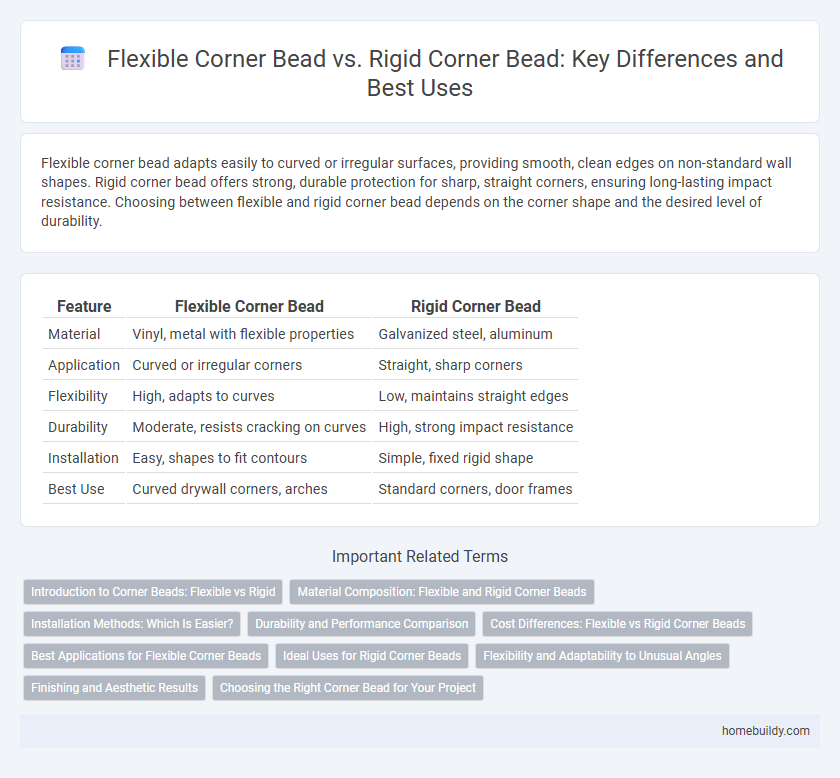Flexible corner bead adapts easily to curved or irregular surfaces, providing smooth, clean edges on non-standard wall shapes. Rigid corner bead offers strong, durable protection for sharp, straight corners, ensuring long-lasting impact resistance. Choosing between flexible and rigid corner bead depends on the corner shape and the desired level of durability.
Table of Comparison
| Feature | Flexible Corner Bead | Rigid Corner Bead |
|---|---|---|
| Material | Vinyl, metal with flexible properties | Galvanized steel, aluminum |
| Application | Curved or irregular corners | Straight, sharp corners |
| Flexibility | High, adapts to curves | Low, maintains straight edges |
| Durability | Moderate, resists cracking on curves | High, strong impact resistance |
| Installation | Easy, shapes to fit contours | Simple, fixed rigid shape |
| Best Use | Curved drywall corners, arches | Standard corners, door frames |
Introduction to Corner Beads: Flexible vs Rigid
Corner beads serve as essential components in drywall installation to create sharp, clean edges at wall corners. Flexible corner beads adapt easily to curved or irregular surfaces, offering superior versatility in complex architectural designs. Rigid corner beads provide strong, straight edges ideal for standard right-angle corners, ensuring durability and impact resistance in typical wall constructions.
Material Composition: Flexible and Rigid Corner Beads
Flexible corner beads are typically made from materials such as vinyl or thin metal strips that allow bending and shaping to fit curved or irregular corners, enhancing adaptability in drywall finishing. Rigid corner beads consist of materials like galvanized steel or aluminum, offering robust protection and sharp, defined edges for standard 90-degree corners. The choice of material composition directly impacts durability, flexibility, and ease of installation in interior wall applications.
Installation Methods: Which Is Easier?
Flexible corner bead is easier to install on curved or irregular surfaces due to its pliability, allowing it to conform smoothly without extensive cutting or shaping. Rigid corner bead requires precise measuring, cutting, and fastening straight edges, making installation more labor-intensive on non-linear corners. Choosing flexible corner bead reduces installation time and complexity, especially for arches or rounded corners, while rigid corner bead suits standard 90-degree angles with straightforward application.
Durability and Performance Comparison
Flexible corner bead offers superior durability in curved or irregular wall applications, adapting seamlessly to contours without cracking or breaking. Rigid corner bead provides robust protection and maintains sharp, clean edges on straight corners but is prone to damage under impact or stress. Performance-wise, flexible corner bead ensures longer-lasting finishes in dynamic environments, while rigid corner bead excels in traditional, high-impact areas requiring structural reinforcement.
Cost Differences: Flexible vs Rigid Corner Beads
Flexible corner beads generally cost more than rigid corner beads due to their specialized materials like vinyl or metal with flexible slits that accommodate curved surfaces. Rigid corner beads, typically made of galvanized steel or aluminum, are more affordable and suitable for straight corners but lack adaptability for non-linear applications. Choosing between them depends on budget constraints and the complexity of the corner design, with flexible options increasing initial expenses but potentially reducing labor costs on curved installations.
Best Applications for Flexible Corner Beads
Flexible corner beads are ideal for curved or rounded wall corners where traditional rigid corner beads cannot conform to the shape, providing smooth and consistent finishes. They excel in applications such as arches, bay windows, and barrel ceilings, ensuring durability and crack resistance along complex contours. Their adaptability reduces installation time and enhances the aesthetic appeal of non-linear drywall edges.
Ideal Uses for Rigid Corner Beads
Rigid corner beads are ideal for protecting and reinforcing external drywall corners in high-traffic areas, providing a durable edge resistant to dents and impacts. They are best suited for straight corners in commercial buildings, warehouses, and residential spaces where structural strength is crucial. Compared to flexible corner beads, rigid varieties offer superior support for sharp, 90-degree angles without compromising the integrity of the corner.
Flexibility and Adaptability to Unusual Angles
Flexible corner bead offers superior adaptability for walls with unusual or curved angles, allowing seamless installation without cracking or gaps. Rigid corner bead is best suited for standard 90-degree corners, providing strong, straight edges but limited flexibility. Choosing flexible corner bead enhances durability and finish quality in non-linear or irregular wall designs.
Finishing and Aesthetic Results
Flexible corner bead adapts easily to curved or irregular surfaces, ensuring smooth transitions and a seamless finish that enhances aesthetic appeal. Rigid corner bead provides crisp, sharp edges ideal for straight corners, resulting in a clean and polished look with durable protection against impacts. Selecting between flexible and rigid corner bead directly impacts the final drywall appearance and overall wall durability.
Choosing the Right Corner Bead for Your Project
Flexible corner bead adapts easily to curved or irregular surfaces, ensuring smooth, professional finishes on arches and rounded walls, while rigid corner bead provides strong, straight edges ideal for sharp 90-degree corners in drywall installations. Selecting the right corner bead depends on the specific project requirements, such as wall shape and desired durability; flexible types are preferred for architectural curves, whereas rigid varieties are best suited for standard, angular corners. Proper corner bead choice enhances drywall longevity, impact resistance, and overall aesthetic appeal, reducing repair and maintenance needs over time.
Flexible corner bead vs Rigid corner bead Infographic

 homebuildy.com
homebuildy.com